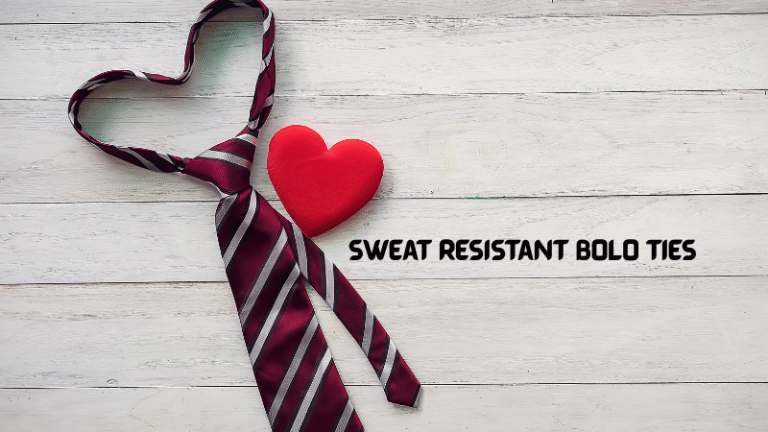Sweat Resistant Bolo Ties, In the shimmer of a summer afternoon, the bolo tie catches the light—its slide polished and gleaming, its cord lying proudly against a crisp shirt. It is a symbol of heritage, of the wide-open West, and of men and women who carry their history around their necks. Yet, under the weight of the sun and the dance of the day, even the most elegant bolo tie has faced an old enemy: sweat.
Sweat is the invisible saboteur. It seeps into fabric cords, tarnishes metal tips, and leaves a mark not only on the accessory but on the dignity of the wearer. This is where the sweat-resistant bolo tie steps in—not as a compromise, but as an evolution.
No longer must style yield to comfort, or tradition to practicality. Modern sweat-resistant bolo ties offer a promise: elegance that holds its ground, even when the day burns hot and the night keeps you on the dance floor.
The Legacy of the Bolo Tie
The bolo tie’s story begins in the mid-20th century, though its spirit stretches back far further. Worn by cowboys and ranchers, it was a piece of practicality turned into art—a way to hold together a collar without the formality of a necktie, yet still bearing the marks of personality.
In Arizona, the sweat resistant bolo ties was embraced so fully it became the official state neckwear. Elsewhere, it became a symbol of rugged individuality, of rebellion against the constrictions of traditional formalwear. But its adaptability gave it reach—soon, bolos were spotted not just at rodeos, but at rock concerts, political rallies, and high-profile galas.
Culturally, it bridges the gap between the dust of the prairie and the gloss of the ballroom. Its materials tell a story—braided leather cords that carry the scent of saddle shops, silver tips that recall the artistry of native silversmiths, and slides that range from turquoise inlays to modern steel engravings.
And now, with sweat-resistant technology woven into its cords and slides, the bolo tie is ready for a new chapter—one that honors its heritage while answering the needs of today’s wearer.
The Problem with Traditional Bolo Ties
As beautiful as the classic bolo tie is, it has always carried a quiet vulnerability. Leather cords, though rich in character, absorb moisture readily. A long summer wedding, an outdoor rodeo, or even a night of dancing can leave the cord stiff, warped, or darkened from sweat.
Metal tips and slides—whether in sterling silver, brass, or plated alloys—are no less at risk. Perspiration contains salts and oils that, over time, corrode, tarnish, or dull their shine. Even in cooler climates, skin oils can leave a residue that builds over repeated wearings.
For collectors, this means constant maintenance: wiping after every use, conditioning leather, polishing metal. For casual wearers, it means avoiding the bolo on days when heat and movement are inevitable.
And so, for decades, bolo lovers faced a choice: wear their prized piece and risk damage, or keep it safe in a drawer, waiting for the rare perfect-weather occasion. It was a quiet compromise—until sweat-resistant designs changed the equation entirely.
Enter the Sweat-Resistant Bolo Tie
The sweat-resistant bolo tie is not a gimmick—it is the result of deliberate innovation. Designers and craftsmen have studied the points of vulnerability in traditional bolos and answered them with modern materials and treatments.
The cords may be made from synthetic braids that mimic the look of leather but repel moisture. Some use wax-coated fibers that form a barrier against sweat without sacrificing flexibility. Others employ high-grade paracord sheathed in decorative weave, offering both strength and resilience.
Slides and tips benefit from similar ingenuity. Stainless steel resists corrosion. High-polish titanium holds its shine through long wear. Even traditional silver can be treated with protective coatings that shield it from skin oils.
The result is a bolo tie you can wear confidently in the heart of summer, under stage lights, or during a long day at the fair. The worry of stains, discoloration, or cord fatigue fades, leaving only the pleasure of the accessory itself.
Choosing the Right Sweat-Resistant Bolo Tie
Not all sweat resistant bolo ties are created equal, and the joy is in finding one that suits both your style and your needs.
Cord Materials:
-
Waxed synthetic braid: Offers the appearance of leather with water-repellent properties.
-
Paracord: Extremely durable, available in a variety of colors, and resistant to fraying.
-
Polyester blends: Lightweight, flexible, and quick-drying.
Slides and Tips:
-
Stainless steel: Durable, resistant to tarnish, and holds polish.
-
Coated silver: Preserves the traditional look while reducing maintenance.
-
Resin or composite: Lightweight, often used for creative, colorful designs.
Comfort Features:
Look for adjustable slides with smooth operation, ensuring you can reposition the tie without catching or fraying the cord. If you have sensitive skin, hypoallergenic metals can make all the difference in long-wear comfort.
Selecting the right sweat-resistant bolo tie is as much about feel as it is about function. It should rest lightly yet confidently at your collar, moving with you rather than against you. The best ones feel like they’ve been part of your wardrobe forever, even the first time you wear them.
